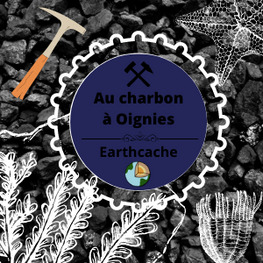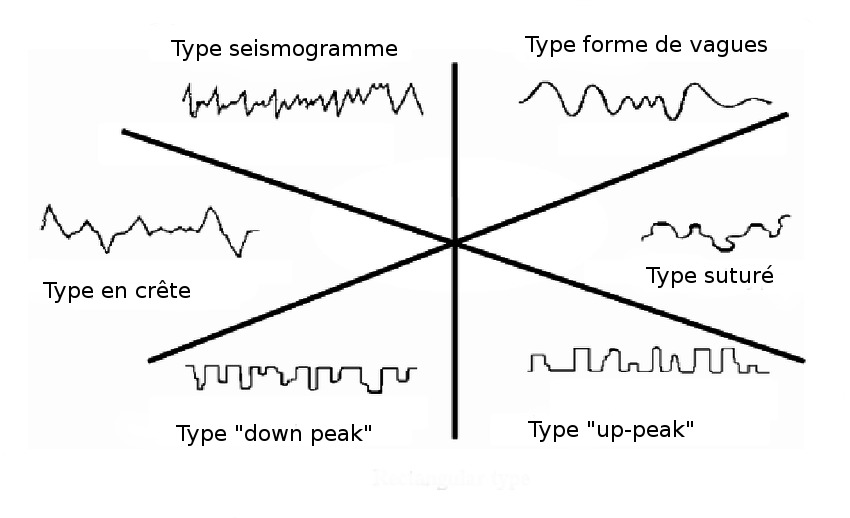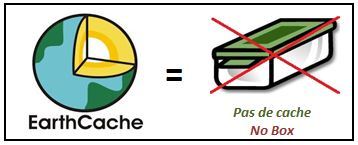

Cette cache a été posée à l'occasion du Mega évent "Au Charbon" à Oignies GC9XH0Z. Ce rassemblement a été voulu par les organisateurs comme un moment de convivalité entre passionés de Geocaching, de nature et de patrimoine. Notre volonté est de permettre à chaque profil de joueur de pouvoir pratiquer ce loisir comme il le souhaite et de partager avec d'autres des moments de rassemblement et de partage autour d'un site emblématique du bassin minier du Pas-de-Calais : Le carreau de fosse du 9-9bis de Oignies.
Les stylolithes
Cette Earth Cache a pour but de vous faire découvrir les stylolithes.
Définition
Le nom de stylolithe (ou stylolite) vient du grec "stylos", pilier et "lithos", pierre.
Ce sont des surfaces en dents de scie au cours de laquelle la matière minérale a été éliminée par dissolution sous pression, dans un procédé qui diminue le volume total de roche.
Les joints stylolithiques sont des discontinuités très irrégulières, hérissées de pointes (pics stylolithiques) plus ou moins aigues, et matérialisées par une accumulation de minéraux argileux, d'oxyhydroxydes de fer etc., au sein du joint. Ils ne sont bien développés que dans les calcaires. Ces joints sont généralement plus sombres que la roche.
Les stylolithes peuvent être colorés. Les couleurs proviennent généralement d'imprégnations d'oxyde de fer ou de manganèse, semblables aux dendrites des roches sédimentaires. D'autres roches sédimentaires contiennent des couches argileuses et des dépôts de malachite le long des structures stylolithiques. Les dépôts colorés sont des résidus de minéraux qui ne se sont pas dissous pendant la compression. Dans certains cas, la calcite et le quartz accompagnent la surface irrégulière des structures stylolithiques.
Géométrie
La géométrie des joints stylolithiques a été définie par Park and Schot, et comporte six formes essentielles:
- forme simple ou primaire comme une vague
- forme suturée
- forme "up-peak" (rectangulaire)
- forme "down-peak" (rectangulaire)
- forme en crête (conique et pointue)
- forme de sismogramme

Relation avec le litage
Six types ont été définis. Trois simples et trois mixtes, on ne s'attardera que sur les trois premiers.
- stylolithes horizontaux: c'est le type le plus couramment observé. Ces stylolithes se produisent parallèlement ou presque parallèlement à la stratification des roches. Ce type est le plus souvent trouvé dans des roches sédimentaires stratifiées, principalement dans les roches carbonatées, qui n'ont pas été affectées par une activité tectonique structurelle ou métamorphique intense.
- stylolithes verticaux: ce type de stylolithe est lié à la stratification à angle droit. Il peut ou non être associé à une activité tectonique. Il est causé par une pression agissant perpendiculairement au litage.
- stylolithes inclinés: ce type est oblique à la stratigraphie. Il apparaît dans des roches qui sont à la fois affectées ou non affectées par l'activité tectonique, et peut également être trouvé dans les roches ignées et métamorphiques.
- il existe également 3 types mixtes (stylolithes inclinées horizontalement (vertical) transversales / stylolithes verticalement inclinées (horizontales) transversales et les stylolithes d'interconnexion du réseau)

Sources
Comment valider cette Earth Cache
Petit rappel concernant les "Earth Caches": il n'y a pas de contenant à rechercher, ni de logbook. Il suffit de se rendre sur les lieux, de répondre aux questions ci-dessous. Vous pouvez loger en "Found it" et envoyez-moi vos propositions de réponses, soit via mon profil, soit via la messagerie geocaching.com (Message Center), et je vous contacterai en cas de problème.

Localisation
Lorsque vous êtes sur la place de l'église, dirigez vous vers l'entrée de l'édifice. Sur votre gauche se trouve un bloc cubique gris clair.


Questions
- 1a: comment expliquer la formation des stylolithes?
- 1b: que trouve-t'on dans les joints stylolithiques?
- 2a: observez le stylolithe, quelle est sa géométrie?
- 2b: en observant les éléments les plus clairs de ce bloc, vous devez être en mesure de repérer le plan de stratification; la relation du stylolithe avec le litage est de quel type (faire le tour du bloc peut également vous aider)?
- 3: une photo de vous ou d'un objet vous représentant, est obligatoire pour valider cette Earth Cache.
Merci par avance de ne pas poster de spoiler dans vos logs!
Bon Geocaching!


This cache was placed during the Mega vent "Au Charbon" in Oignies GC9XH0Z. This gathering was wanted by the organizers as a moment of conviviality between enthusiasts of geocaching, nature and heritage. The desire is to allow each profile of player to be able to practice this leisure as he wishes and to share with others moments of gathering and sharing around an emblematic site of the mining basin of Pas-de-Calais: the pit tile of 9-9bis of Oignies.
Styloliths
This Earth Cache aims to make you discover styloliths.
General
The name of stylolite (or stylolithe) comes from the Greek "stylos", pillar and "lithos", stone.
These are sawtooth surfaces during which the mineral material has been removed by dissolution under pressure, in a process that decreases the total volume of rock.
The stylolitic joints are very irregular discontinuities, bristling with spikes (stylolitic peaks) more or less acute, and materialized by an accumulation of clay minerals, iron oxyhydroxides, etc., within the joint. They are well developed only in limestones. These joints are usually darker than the rock.
Styloliths can be coloured. The colours are usually derived from iron oxide or manganese impregnations, similar to dendrites in sedimentary rocks. Other sedimentary rocks contain clay layers and malachite deposits along the stylolithic structures. The coloured deposits are residues of minerals that did not dissolve during compression. In some cases, calcite and quartz accompany the irregular surface of the stylolithic structures.
Geometry
The geometry of the stylolitic joints has been defined by Park and Schot, and comprises six essential forms:
- simple or primary shape like a wave
- sutured form
- "up-peak" shape (rectangular)
- "down-peak" shape (rectangular)
- crest shape (conical and pointed)
- seismogram shape

Relationship with bedding
Six types have been defined. Three simple and three mixed, we will forget the last three!
- horizontal stylolites: this is the type most commonly observed. These Stylolites occur parallel to or almost parallel to the stratification rocks. This type is most often found in sedimentary rocks stratified, mainly in carbonate rocks, which were not affected by intense structural or metamorphic tectonic activity.
- vertical stylolites: this type of stylolite is related to the stratification at an angle law. It may or may not be associated with tectonic activity. It is caused by a pressure acting perpendicular to the bed.
- inclined stylolites: this type is oblique to stratigraphy. It appears in rocks that are both affected or unaffected by tectonic activity, and can also be found in igneous and metamorphic rocks.
- there are also 3 mixed types (horizontally inclined stylolites (vertical) transverse / vertically inclined (horizontal) stylolites transverse and network interconnection stylolites)

Sources
How to validate this Earth Cache
A reminder about the "Earth Caches": there is no container to look for, nor a logbook. You just have to go to the place and answer the questions below. You can log in "Found it" and send me your suggestions for answers, either via my profile, or via the geocaching.com message center, and I will contact you if there is a problem.

Location
When you are in the church square, walk towards the entrance of the building. On your left is a light grey cubic block.


Questions
- 1a: how can the formation of styloliths be explained?
- 1b: what is found in the stylolithic joints?
- 2a: look at the stylolith, what is its geometry?
- 2b: by observing the lighter elements of this block, you should be able to locate the stratification plane; the relationship of the stylolith to the bedding is of what type (walking around the block may also help you)?
- 3: a photo of you or an object representing you is mandatory to validate this Earth Cache.
Thank you in advance for not posting spoilers in your logs!
Happy Geocaching!
